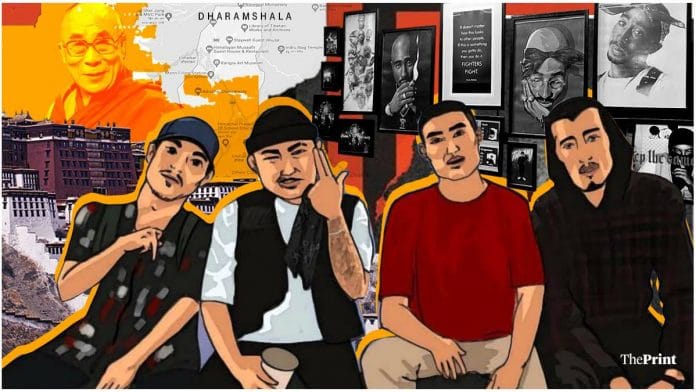From a tool of resistance in Tibet beginning with 14 “singing nuns” or Drapchi 14 who protested against China’s oppression by making “forbidden” pro-independence songs while in prison in the 1990s, music has now become a medium of self-expression for a rising number of young Tibetan refugees in India. They are unafraid of speaking their minds in rap songs with explicit content in a bid to represent the buried voices and emotions of the youngsters in the Tibetan community. The songs are not just about Tibet anymore, they cover everything from why Indians shouldn’t think they are from the Northeast, their own vulnerabilities, problems with their dads, and ‘bad karma’. The young rappers want to introduce their community to hip-hop, they are done with ‘feel good’ songs.
Very few believed in them when they first started off making rap songs in their tiny bedrooms in Delhi’s Majnu Ka Tilla, a locality in North Delhi that has been the home for thousands of Tibetan refugees in India since the 1950s. From releasing short songs on YouTube to performing at small gigs, young Tibetan rappers such as Tnammy and Sangpo have done it all. Now, these artists who claimed to have introduced the tiny Tibetan community to hip hop, are coming up with their new albums this February. “WIT” (Who Is Tnammy) by Tenzin Namsel aka Tnammy and “Midnight Vibes” by Sangpo aka Sangpoispo are up for pre-save on streaming platforms like Apple and Spotify.
“This is where the magic happens,” says 24-year-old Tnammy, as he unlocks the tiny room on the roof of his house situated in one of the many narrow lanes of Majnu Ka Tilla.
Inside Tnammy’s red-walled room is a bunch of photo frames safeguarding one man: Tupac Shakur. Tnammy grew up listening to the American rapper since he was a sixth-grade student in a boarding school in Dharamshala. “Tupac used music as a platform to explore issues plaguing his community, whether it be racial inequality, social justice or war on drugs”.

“I also wanted to address the issues faced by my community through my music”, he added. From soldiers in Indian army to young kids in the lanes of Majnu Ka Tilla, Tnammy seems to have carved his own niche audience within the exile community.
Music has always been a medium for Tibetans to express anger and frustration against the authoritarian Chinese government in Tibet. Many such musicians in Tibet were detained for at least two years by Chinese authorities for writing songs about their exiled spiritual leader the Dalai Lama, demanding his return to the country and calling for Tibet’s independence. These cultural figures dared to sing despite China’s blanket ban on making or even downloading and listening to such songs. Probably because, as described by Tsering Woeser, author of Notes on Tibet, “anyone hearing them could not fail to be moved”.
Talking about freedom and human rights in songs has naturally become a crucial responsibility for most Tibetan singers and songwriters in India, with many producing at least one or two songs as a wake-up call to the exiled members of the community.
The lyrics of such songs often tend to remind Tibetans not to forget 1959, the year Tibet was invaded by the People’s Republic of China (PRC), and promise to take the Dalai Lama back to the Potala Palace in Lhasa one day. This is also something that Tnammy has tattooed behind his shoulder.

Also read: Delhi’s Majnu ka Tila loses connect with home Tibet after app ban, looks for alternative
A new generation steps in
In Tnammy’s song “1945”, which he claims was particularly well-received by many young Tibetan soldiers in the Indian army, he takes a sly dig at the Chinese government for being an enemy in disguise. “They wanted to be our closest friend, but we didn’t notice the knife they hid behind their back,” reads the lyrics. After the year 1945, tensions between China and Tibet started brewing.
“1945 made our brothers at the border aggressive for the right reasons. I could not be more proud,” Tnammy said, adding that he wrote the verses in all three languages he knew—Tibetan, Hindi and English—so that more people understand “how these people who they think are from the Northeast ended up settling in the lanes of Majnu Ka Tilla”.
In another song titled “Made in Tibet”, which he wrote in collaboration with US-born Tibetan singer Shabaley, Tnammy grieves the death of over 150 of his countrymen and women who set themselves on fire to demand the independence of Tibet.
The lines go:
“...Joh jaan diya unka bhi hai pariwar,
Upar dekha, mujhe tujh se naraz that,
Kaisa socha tuna yahin toh hai rasta,
Aapne ma ko chora tune yeh toh dekh na,
Phir bhi nas hai, tujh pe garv hai…”
Tibetan singer, songwriter and rapper Gtashi’s song “Freedom Freestyle”, made in collaboration with rapper Tenzin Kunsang or K.Kush, also has a similar message. Gtashi is based in Dharamshala.
However, the new generation of Tibetan rappers and artists are not limiting themselves to just that, they, unapologetically, have dared to go beyond Tibet. They produce songs on events that have shaped their lives, not shying away from talking about broken dreams, vulnerabilities and rejections.

“As a Tibetan refugee living in exile, talking about freedom and human rights in our songs is a crucial responsibility. But as a passionate musician, I focus more on the diversity of Tibetan music in our community, trying to come up with a new taste of music which I grew up listening to,” Gtashi told ThePrint.
Notwithstanding the curse words (with bleeps), which aren’t so common in earlier Tibetan songs, their rap music stands out for painting a more realistic representation of the lives of refugees, expressing raw emotions with bold, explosive lyrics that many youngsters in the community relate to.
G Tashi and K.Kush’s “Can you hear me” hits viewers with its unconventional, sharp lyrics that lay bare their struggle to survive as artists. “Is anyone even listening to these songs we have put our hearts into anymore,” ask the singers.
“Is it because of my bad karma, or have I taken the wrong path
Cause I don’t see any result of my hard work till now
I am stuck in the backstage making beats for people
But those with money buy themselves the whole stage”

“I may get big cheques but I still continue to rap,” says Abu Rigdo, a relatively young rapper, who was born and brought up in India and currently lives in Paris. “You can never stop a person who has got R (Refugee) on their head no matter how dark his path is,” he says in a song called “Snake” made in collaboration with Tnammy and Ngale.
Also read: IAS aspirant to auto driver — how Chennai’s gully boys & girls fight inequality with music
‘I will teach you how to rap’
If the “unsung heroes” inside Tibet had dared to talk about freedom in Tibet, these millennials have dared to rap about breaking social stigmas in the exile community in India.
Also unmissable in their songs is the open display of anger, hatred and frustration, a far cry from what renowned Tibetan musicians and songwriters, including Techung and Phurbu T.Namgyal who set the benchmark for classic, feel-good Tibetan music in the past decade, had to offer. If one’s to judge by the lyrics, the anger and hostility in their voice seem to be a passive response to how the conservative society still looks at them as social misfits, glorifying the “thug life”.
“The new Tibetan rappers are a breath of fresh air. What we express in our songs are very raw and real. Tibetan artists who came before us were more dedicated to making songs that you can enjoy with your family on good occasions. Ours tries to motivate and provide, even for a few minutes, an escape from the ugly reality they may be facing,” Jigme Woser, whose stage name is 8asian, told ThePrint.

“If you really want to kill someone, go kill a Chinese spy. I am a Khampa phosa, I fear no one,” raps Tnammy in his recent song Snake.
It was with the song Tibetan Cypher 2020 that rappers like Tnammy, Gtashi, K.Kush, and 8asian, unofficially introduced the tiny Tibetan community to hip hop. “Come here friend, I will teach you how to rap,” reads one line.
But not everything is hunky-dory when a refugee wants to take a path less taken.
The making of rappers with an “R”(Refugee): A losing battle at first
Gtashi’s first song “Pala”, meaning father in Tibetan, was about him sharing a bitter relationship with his father who didn’t approve of him taking up music as a profession.
“Pala was my first song where I expressed myself and my relationship with my dad, a typical story about why I couldn’t grow up as per his expectation”, Gtashi said.
While he still has to work various side jobs like making beats for organisations and taking DJ shifts at night to make a living, Gtashi regrets studying political science in college and not pushing himself hard enough to pursue music. However, the person who helped him get through those draining three years was singer Jermaine Lamar Cole or J. Cole. “I first encountered him during my second year of college and, believe it or not, it helped me finish my college studies. His style of writing and the message he tries to convey hits home pretty hard,” Gtashi explained, calling Cole’s album Forest Hills Drive his favourite.
Also read: Rs 38 lakh in 3 hours: How rapper & anti-caste activist from Odisha managed his Oxford dream
Music before refugee status
For most of these artists, trying to make their families understand their passion to become rappers felt like a losing battle.
Tnammy, who had always wanted to be a rapper since he started scribbling and memorising Tupac’s lyrics, believes it’s the result of typical social stigmas. In the Tibetan community, the urge to get one’s child educated is even stronger because most parents themselves have been deprived of educational opportunities.
Tnammy says he gave in to their initial demand of going to college and getting a Bachelor’s degree in Arts from Delhi University and even tried to keep himself busy by becoming a tattoo artist. But he, in his words, “failed to put music second in life”, making him confront his parents again.
“In our society, we are so conditioned to believe that to be included in a society you need to go to a college and do what the majority is doing. If you choose to look the other way or try something new, you are shamed along with your family. My parents like many others were victims of this mentality,” Tnammy explains.
Yes, it is difficult to be a rapper, but it is not impossible. “Although, we can’t compare our journey with, say, an Indian rapper, most of whom are privileged and can promote themselves better in the rap industry, being a refugee doesn’t stop us from doing what we want to do,” 8asian says. “If you really have the talent, no one will judge you for being a refugee.”






